A pressure injury results when there is localized damage to the skin and underlying tissue as a result of compression between a bony prominence and an external surface. Damage is caused by the forces of pressure, shear, friction, and moisture. Typical sites of formation are the sacrum, followed by the heels.
A primary cause of pressure injury formation is immobility. Constant pressure for a time period of 2 hours is all that is required to initiate an ischemic event and cause ulceration. Other risk factors that predispose to ulcer formation include incontinence, nutritional deficits, old age, decreased mental faculties, and malnutrition.
These ulcers may go on to develop into stage 2 ulcers, or treatment may halt their evolution to further stages.
When examining the ulcer, observe the following:
- Location on the body
- Staging of the ulcer
- Size of the ulcer, which should include width and the length in centimeters
- Skin around the edges of the ulcer – The periwound skin should be assessed for color, texture, temperature, and integrity of the surrounding skin.
- Presence or absence of pain
- Odor, if present or absent
- Medical device-related pressure injury (describes an etiology) – Results from the use of devices designed and applied for therapeutic purposes. Injury generally conforms to the pattern or shape of the device. Stage using the staging system.
- Mucosal membrane pressure injury – Found on mucous membranes with a history of a medical device in use at the location of the injury. Cannot be staged due to anatomy of tissue.



